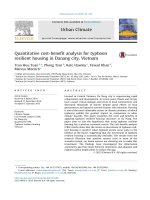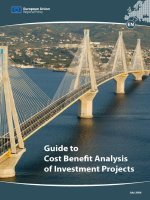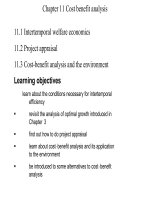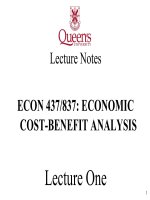ECONOMIC COST BENEFIT ANALYSIS
Bạn đang xem bản rút gọn của tài liệu. Xem và tải ngay bản đầy đủ của tài liệu tại đây (4.93 MB, 49 trang )
Lecture Notes
ECON 437/837: ECONOMIC COST-BENEFIT ANALYSIS
Lecture One
1
COST-BENEFIT ANALYSIS:
An Integrated Approach
2
The Role of Investment Appraisal
•
•
•
•
•
To stop bad projects – bad policies
To prevent good projects from being destroyed
To determine if components of projects are consistent
To assess the sources and magnitudes of risks
To determine how to reduce risks and efficiently share risks
3
Questions addressed by an Integrated
Investment Appraisal
•
•
•
•
Is the project financially viable or fiscally sustainable?
Does the project contribute to the economic growth of the country? i.e., positive expected economic NPV?
Who are beneficiaries of project and by how much?
Who are the interest groups (stakeholders) who could distort the investment decision or affect the project’s
performance?
•
•
•
•
•
What are the sources and magnitudes of risk?
What are the risks associated with the benefits accruing to the stakeholders? Sources of political risks?
Are poverty alleviation goals being addressed?
What are the fiscal impacts?
What is the personality of the project?
4
Impact of Analysis
•
Quality of analysis has been shown by the World Bank to be a key determinant of the success of a
project’s performance.
•
•
A proper analysis will cause the project to be redesigned so that it is less likely to fail.
World Bank experience shows that the probability of failure for poorly prepared projects within 3
years of a project’s life is 7 times that of well-prepared projects.
•
Poorly prepared projects have 16 times as high a probability of failure within 5 years as compared
to well-prepared projects.
5
Incrementality of Projects
•
One of the important concepts when defining a project is to measure the impact of the project’s cash flows and net benefits and costs on an
incremental basis.
•
We should carefully identify the benefits and costs that are only associated with the project, and not include any other benefits that would exist
“WITHOUT” the project being undertaken.
•
•
It is normal for the benefits and costs to change over time for the “WITHOUT” project case.
The “WITHOUT” project scenario must be properly defined before using it as the base case from which to measure incremental benefits and
costs produced by the “WITH” project case.
•
It is an optimized “WITHOUT” project situation that should be compared with the “WITH” project situation to calculate the incremental
benefits and costs.
•
There is another perspective “before the project” versus “after the project” scenarios. “Before the project” is NOT the appropriate base case
from which to measure incremental benefits and costs.
6
Components of Investment Appraisal
•
Stages in Project Appraisal and Approval
A. Idea and Project Definition
B. Pre-Feasibility Study
C. Feasibility and Financing
D. Detailed Design
E. Project Implementation
F. Ex-Post Evaluation
7
A. Key Questions at Idea Stage
a. Where is the demand?
b. Is this project consistent with the
organization’s expertise, current plans and strategy for the
future? Can the project be implemented and operated in a reasonably efficient matter?
8
Project Definition
•
Project definition is defined broadly to include the scope and specification of the objectives of the
project, its output, its different stakeholders, its economic and social benefits, and the data
requirements.
•
Most of the project’s data requirements are identified in the pre-feasibility and feasibility stages of the
project where the project’s variables and parameters are analyzed in detail.
9
B. Pre-Feasibility Study
•
•
•
Examines overall potential of project
Should maintain same quality of information across all variables
Wherever possible should use secondary information
Key questions:
a.
b.
c.
d.
Is this project financially and economically feasible throughout the project’s life?
What are the key variables?
What are the sources of risk?
How can the risk be reduced?
10
C. Feasibility Study
•
•
•
Focus is on improving accuracy of the key variables
Alternatives for reducing risk are examined in detail
Some primary data may be needed
Key questions:
a. Is project financially attractive to all interested parties in activity?
b. What is level of uncertainty of key variables?
c. How is the project financed?
d.
Can final decision for approval be taken?
11
Modules of Pre-Feasibility
and Feasibility Studies
The data for a pre-feasibility study are generally arranged in what we refer to as “building blocks” because they
constitute the foundation for the different types of analyses.
Building Blocks
A. Demand Module
B. Technical Module
C. Environmental Assessment Module
D. Human Resources and Administrative Support Module
E. Institutional Module
Analysis Modules
F. Financial/Budget Module
G. Economic Module
H. Social Appraisal or Distributive and Basic Needs Analysis
12
Building Block A: Demand Module
•
•
•
Study of sources of demand, nature of market, prices and quantities
Major distinction between domestic versus internationally traded goods and services
For internationally traded goods, prices are given to the project by world markets
– Secondary information most important
•
For domestic market, primary research more important
Output of Module
a.
b.
Forecast of quantities and real prices for life of project
c.
Environmental impacts
Taxes, tariffs, subsidies, public regulations, technological trends
13
Building Block B: Technical Module
•
•
•
A study of input requirements for investment and operations and their costs
In this module, secondary information can be used very effectively
Need to avoid conflict of interest between supplier of technical information and seller of investment
equipment, or contractor for construction
Output of Module
a.
b.
c.
d.
e.
Technology and life of project
Quantities of inputs by type needed for investment and operation
Labor required by type and time
Input prices and sources of supply
Environmental impacts
14
Building Block C: Environmental Assessment Module
• Environmental assessment augments information for the
economic analysis
• Identification of environmental impacts and risks
• Where possible, quantify the environmental impacts
Key Questions:
a. What are the likely environmental impacts from undertaking
project?
b. What is the cost of reducing the negative impact?
c. Evaluation of the environmental impacts and risks with and
without technical measures are taken to reduce these impacts?
d. Are there alternative ways of supplying the good or service of
project without incurring these environmental costs? What are
the costs of these alternatives?
15
Building Block D: Human Resources and
Administrative Support Module
•
•
•
•
•
What are managerial and labor needs of the project?
Does organization have the ability to get the managerial skills needed?
Is timing of project consistent with quantity and quality of management?
What are wage rates for labor skills required?
Manpower requirements by category are reconciled with availabilities and project
timing.
16
Building Block E: Institutional Module
•
•
This module deals with the adequacy of the institution responsible for managing the different stages or phases of
the project.
Insufficient attention to the institutional aspects creates serious problems during the implementation and operations
phases of the project.
Key Questions:
a.
b.
c.
Is the entity that is supposed to manage the project properly organized and its management adequately equipped to
handle the project?
Are the capabilities and facilities being properly utilized?
Is there a need for changes in the policy and institutional set up outside this entity? What changes may be needed
in policies of the local, regional and central governments?
17
Analysis Module F: Financial Module
What is done:
•
•
•
Integration of financial and technical variables from demand module, technical module, and
management module
Construct cash flow profile of project
Identify key variables for doing economic and social analysis
Key questions:
a.
What is relative certainty of financial variables?
b.
What are sources and costs of financing?
c.
What are minimum cash flow requirements for each of the stakeholders?
d.
What can be adjusted to satisfy each of the stakeholders?
18
Analysis Module G: Economic Module
What is done:
•
•
Examines the project using the whole country as the accounting entity
Evaluation of externalities including environmental
Key questions:
a.
What are differences between financial and economic values for a variable?
b.
What causes these differences?
c.
With what degrees of certainty do we know values of these differences?
d.
What is the expected value of economic net benefits?
e.
What is the probability of positive economic feasibility?
19
Analysis Module H: Stakeholders and Basic Needs Analysis
What is done:
•
•
•
•
Identification and quantification of extra-economic impacts of project
Income, cost, and fiscal impacts on various stakeholders
Poverty alleviation and political necessities
Basic Needs: Evaluate the impact of project on achieving basic needs objectives
– Basic needs will vary from country to country
Key Questions:
a.
In what ways does project generate beneficial and cost impacts on stakeholders?
b.
What stakeholders could the project impact?
c.
Who benefit and who pay the costs?
d.
What are the basic needs of the society that are relevant in the country?
e.
What impact will the project have on basic needs?
f.
What alternative ways are there to generate desirable social impacts?
g.
Is project relatively cost effective in generation of desirable social impacts?
20
Integrated Projects
•
•
•
•
•
•
Integrated projects can get very complex and need to be approached cautiously to avoid costly errors.
It is possible for the bundled project to be financially and economically viable even though some of the components are not.
Dropping the components that generate negative returns will maximize the project’s benefits.
Defining and understanding the objectives of the project is particularly important when analyzing integrated projects.
Ultimately, the ‘bundle’ that succeeds the most in accomplishing the desired objectives should be undertaken.
If the objective of the project is to maximize the wealth of people in country, then the component or bundle that yields the highest
economic NPV should be undertaken.
21
ECONOMIC VALUE
ECONOMIC
VALUE
=
FINANCIAL
VALUE
=
+
TAX IMPACT
+
NET BENEFITS TO
CONSUMERS
+
NET LABOUR
BENEFITS
FINANCIAL
VALUE
TAX IMPACT
NET LABOUR
BENEFITS
NET
BENEFITS TO
CONSUMERS
22
General Relationship
NPV
-
ECO
FIN
EXT
eco. dr= NPV
eco. dr+ ∑ PV
eco. dr
Holds when all benefits and costs are discounted using same discount rate.
23
Alternative Points of View
•
•
Critical in analysis to evaluate financial outcome of project from the point of view of each
interested party
Conventional analysis considers:
a. Point of view of owner
b. Point of view of all investors combined
(Banker’s point of view or total investment point of view)
c. Point of view of economy
Other Perspectives
•
•
•
•
Point of view of government budget
Point of view of suppliers of inputs
Point of view of downstream processors
Point of view of competitors
Analyses of Investment Decisions from
Alternative Points of View
Type of Analysis
Financial
Economic
(I)
(II)
(III)
(IV)
Banker (Total Investment)
Yes
No/Yes
Yes
No
Owner
Yes
No/Yes
Yes
No
Government Budget Office
Yes
No/Yes
Yes
No
Country
No
Yes
Yes
Yes
Viewpoint:
Stakeholder Basic Needs
25









